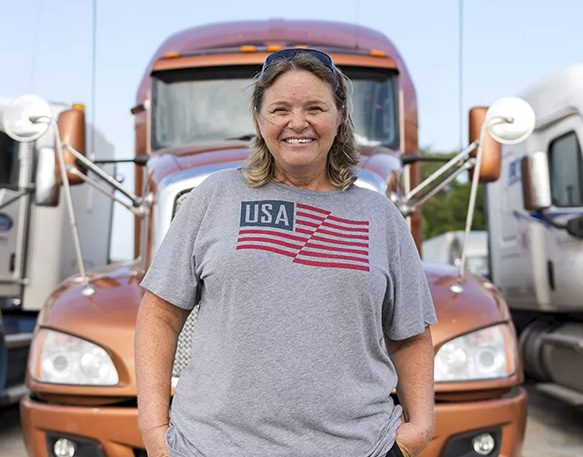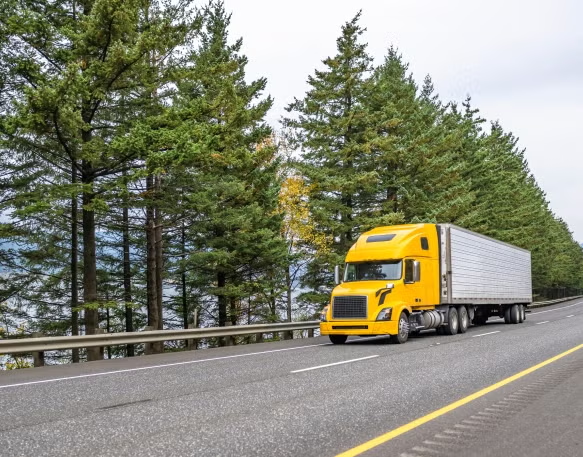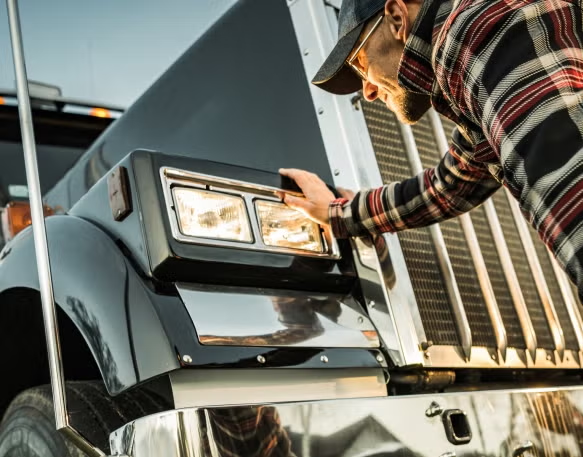Starting any business – trucking, opening a coffee shop, making furniture – can be intimidating at first. But with the proper guidance and resources, you can plan, create, and operate a trucking business that lasts. DAT Freight & Analytics has created this comprehensive guide to help you make informed decisions and set yourself up for an exciting and rewarding career.
This guide provides practical advice on how to arrange your business, manage your finances, and keep your operation running efficiently. It also covers some of the more complex topics you’ll want to understand, like compliance with government regulations and navigating the up and down trucking market cycles.
Of course, any new venture should begin with a solid business foundation – finance, business intelligence, tax implications. If you lack expertise in these disciplines, surround yourself with reliable business partners who can help you manage income and expenses. Without this foundation, you’re just driving a truck.
Ready to start your journey as a trucking entrepreneur? Let’s get started.
I. OPERATING AUTHORITY
So you’ve decided to take the plunge and start your own business. Congratulations! The first step is getting your operating authority – a permit issued by the Federal Motor Carrier Safety Administration (FMCSA) that allows businesses to accept payments to haul freight across state lines.
Operating under your own motor carrier authority offers a range of benefits, including improved career opportunities and increased earning potential. While the potential for higher rewards are there, the risk is higher too. That’s why it’s important to get a full understanding as you’re getting started.
Typically, it takes five to seven weeks to complete the state and federal approval process. Federal approval alone can take around 16 business days. Pair that with filling out BOC-3 process agent forms (required for federal authority), obtaining adequate insurance policies, and paying registration fees, and the process might be a bit more complicated than you’d think. Don’t want to deal with all that hassle? You can partner with DAT to obtain your trucking authority and we’ll make your job easier.
Many carriers also choose to obtain a Transportation Worker Identification Credential, better known as a TWIC card, which enables them to operate within the nation’s maritime ports and airports. Beyond providing access to the often plentiful loads coming into the country, a TWIC card can differentiate a carrier by setting them apart from the majority of carriers who don’t have those credentials.
PREPARE FOR NEW ENTRANT SAFETY AUDIT
During the first year of your business, the FMCSA mandates a new entrant safety audit to ensure your company is following all established safety standards. Carriers are required to submit documents that verify you’ve established safety management procedures and controls, and auditors typically want to see information related to both the drivers and vehicles (as well as general operating and record-keeping procedures). Such audits usually occur at your place of business.
II. REVENUE
RESEARCH MARKETS AND CHOOSE SPECIALIZATION
Dean Croke, principal analyst at DAT Freight & Analytics and a veteran of the trucking industry, says learning the nation’s markets and potential fits for specialization are essential early steps for new carriers.
“It’s the first and most important thing to understand,” he says. “Find your niche in the market. Are you going to haul steel? Lumber? Produce? You have to understand the demand for what it is you haul because if you don’t, you can’t price it properly or negotiate from a position of strength.”
Choosing the market in which you want to operate is equally important, since it will influence the type of truck you acquire. For example, if you decide you want to work within the flatlands of Nebraska, there’d be no point in buying an engine designed to climb hills like “the Grapevine” in California.
HOW TO FIND PROFITABLE LOADS
After you’ve acquired a truck or fleet to serve as the workhorse for your trucking business, the obvious next step is to find paying loads. For the majority of truckers, the easiest and fastest way to do that is with the DAT One load board – a single online resource where shippers and brokers post information about available loads (origin, destination, dates, rates, etc.). As a trucker or owner-operator, you can research these available loads and choose which ones are best for your business.
DAT One also includes essential tools like the Profit Estimator, which enables carriers to determine how much they’ll earn on a load (based on operating costs and goals) before they agree to haul it.
MANAGING CASH FLOW
Cash flow management can sometimes be a challenge for carrier businesses, especially when they’re first starting out. That’s because it can take a month or more to collect payment on an invoice for a load. But there is a magic bullet of sorts that can help you get paid in as little as 24 hours. Freight factoring is when you sell the invoice for a load to a third party (a factor) at a slight discount. In exchange, you get paid that same day rather than waiting for weeks.
In partnership with OTR Solutions, DAT can facilitate invoice factoring that provides almost immediate cash flow – a crucial access point for a new trucking business with evolving operational expenses.
There are two types of factoring: recourse and non-recourse. Recourse factoring is more common. In that arrangement, your factoring company will buy your invoice, giving you the money upfront while they collect payment from your customer. However, if your customer never pays, your factoring company will issue a chargeback, forcing you to return the advance.
On the other hand, non-recourse factoring companies take on the risk of unpaid invoices in exchange for a higher fee. If your customer defaults or makes a late payment, you can still keep the money from your factoring company. It provides more peace of mind, but there’s a catch.
Most accounts receivable factoring companies that claim to offer non-recourse factoring only do so under particular circumstances. For example, your customer must file for bankruptcy between when you submit your invoice and when your customer is supposed to pay it. Since factors carry out broker checks, this is highly unlikely. As a result, non-recourse factoring is usually recourse factoring by another name — and with a higher fee.
III. EXPENSES

BUYING A TRUCK
As is the case with personal vehicles, you have the option to either purchase or lease equipment. Either way, first decide what type of freight you plan to haul. Do you plan on only running day trips, or will you need a sleeper cabin? Will your first truck be a van, a refrigerated trailer (also known as a “reefer”), or a flatbed trailer? Here are some common types of leases:
- Operating (Full-Service) Lease: With this lease, you take care of maintenance, taxes, and permits, and at the end of the lease term you walk away.
- Terminal Rental Adjustment Clause (TRAC) Lease: With this lease, you make a small down payment and at the end of the lease you purchase the truck for its residual value, or you can opt for the leasing company to sell the truck.
- If the leasing company makes money on the sale, you receive the profit, if it loses money, you pay the difference.
- Lease Purchase Plans: Lease-purchase plans are primarily for truckers who don’t have enough for a down payment or have bad credit. Experts say you typically pay more in such arrangements versus traditional financing.
FUEL
When starting a trucking business, it’s important to consider how you’ll save money on fuel costs – especially given that diesel fuel is the single largest expense you’ll manage. Cash flow is critical in the early stage of your business, and keeping fuel costs in check is key.
Fuel cards offer an easy way to save money while keeping track of your spending. They can help you earn rebates and discounts for gas purchases, as well as access flexible payment options that make it easier to budget for vehicles and drivers. Using a dedicated fuel card for diesel purchases is another way carriers can mitigate expenses.
There are other ways businesses like yours can add extra control over fuel costs. Many trucking companies are turning to more efficient vehicles and truck/trailer types designed for maximum aerodynamic efficiency. This can help make the most of every gallon used while staying within budget.
INSURANCE
Operating under your own carrier authority means you also have to invest in cargo insurance.
“Insufficient insurance coverage is a big risk,” says Croke. “A lot of carriers get caught hauling a load that’s worth more than their coverage will permit. If you’re in that situation and there’s an accident or some other calamity, you’ve created a significant problem for yourself. It’s imperative to make sure you have adequate coverage for the value of the commodity you’re hauling.”
Of course, your trucks will also need to be insured. Truckers often face unique risks when it comes to their job, from expensive repairs to severe accidents. Without adequate insurance, a single accident can result in a financial crisis for truck drivers and their families. Even though insurance can be expensive, it’s worth the investment to protect yourself and your assets.
When choosing an insurance provider, make sure you understand what type of coverage is right for you. Choose an insurance company that offers comprehensive coverage, including liability, collision, comprehensive physical damage, cargo, workers’ compensation, and trailer interchange.
Make sure you’re also aware of the different types of deductibles associated with your policy. The deductible is the amount of money you will have to pay out-of-pocket in case of an accident or other covered incident. Different policies may offer different deductibles, so make sure you understand each one.
Look for an insurance provider who understands the unique needs of truck drivers, one with experience in the trucking industry and is familiar with its regulations and requirements. A provider that knows how to assess risk and offers competitive rates can help you get the coverage you need at a price that fits your budget.
In partnership with Marquee Insurance Group (MIG), DAT gives carriers the assurance that their insurance coverage is tailored to address the specific risks you face daily. From safeguarding against cargo damage during transit to protecting against bodily injury claims, MIG ensures you’re adequately covered in every aspect of your operations.
Fortunately, investing in a comprehensive trucking insurance policy can also help protect your business from the financial burden of high diesel fuel costs. With the right coverage, you could be eligible for reimbursement for repairs and replacements caused by unavoidable increases in fuel prices, as well as other components like trailer repair or replacement if it is damaged by harsh road conditions.
Will Post, Enterprise Account Executive at DAT Freight & Analytics, says where you park your truck overnight could have a significant impact on what you’ll pay for insurance.
“Take Southern California for example,” Post says. “You could garage your truck in San Diego. Alternatively, you could garage it, say, 150 miles east of San Diego, where there is less population density and therefore less risk. Those sorts of variables make a difference.”
In most cases, a trucking business is required to hold several types of insurance, including:
- Primary Liability: $750,000 in primary liability coverage is required to cover damage or injury done in case of an accident where you are at fault. Many shippers or brokers require $1 million in primary liability coverage.
- Cargo: $100,000 is the most common request to cover cargo, but this will depend on what you are hauling. This covers damage to the freight and/or theft.
- Physical Damage: Covers truck damage in accidents where you are not liable.
- Non-trucking-use (bobtail): This covers you if you are liable for an accident while you are not hauling a load for someone else.
- Per Load Insurance: Cut your annualized insurance costs and quickly cover specialty loads with fast and cost-effective all-risk smart coverage in fewer than 40 seconds.
Post advises new carriers to be aware that up-front insurance costs can be significant.
“It’s expensive,” he says. “You’re typically looking at a down payment of up to 15-20% plus a monthly payment. Sometimes you can get a discount if you pay all at once. And if something comes up – an illness or a death in the family – and you can’t work for a couple of weeks, you need to have some savings put away to pay those insurance costs regardless of the hardship. If your insurance isn’t up to date, your authority can be turned off.”
SAVINGS
Starting a trucking business requires a big investment upfront to purchase a tractor and trailer(s), plus licensing requirements and registration. Identify sources and terms for financing and secure a line of credit. Experts recommend having enough money saved up to cover your first six months of operation, including your lease payments.
Also, know that the trucking market is cyclical. There are months when the market is red hot, with a wealth of available loads and consistent opportunities to earn money. There are also periods when demand softens and loads are difficult to come by. Having ample savings can help carriers sustain operations during down markets, waiting for demand to return.
Croke suggests carriers employ personal accounting software like Quickbooks to compile relevant data before presenting it to their financial advisor.
“It’s important to understand your cash flow situation,” he says. “If you can do that weekly or monthly, you’ll start to understand your margins better.”
Todd Amen, Chairman and CEO of Denver-based ATBS, is a recognized leader and figurehead in the domain of business and finance for carriers. His insights on these topics are highly sought after.
IV. OPERATIONS
RUNNING YOUR BUSINESS
Establishing efficient operations – from dispatching to accounting, from fleet maintenance to sales – is critical to building a business that’ll last for the long haul. Having the right tools and partnerships can make your new venture both exciting and profitable.
In many cases, “the right tool” is likely to be an experienced professional. While the “trucking” part of a trucking business is intuitive and comes easily to a lot of drivers, the business side is an entirely different story. It’s important that new business owners be willing to identify the boundaries of their own expertise and know when to rely on others when that time comes.
TRUCKING BUSINESS ACCOUNTANT
Operating a business is a far cry from managing one’s personal finances. In business, the professionals who make up your “team” are essential – and an accountant who understands the trucking industry is likely to be your MVP. This is particularly true when it comes to avoiding filing mistakes or an audit. Qualified accountants can also produce a monthly profit and loss (P&L) statement to help you monitor your success.
Finding a financial advisor who understands the trucking industry can be daunting. Look for advisors who have a working knowledge of taxes, benefits, and retirement plans specific to this business. Ask questions about an advisor’s experience working with truckers to ensure they know the ins and outs of the industry. A qualified financial advisor should also be able to explain the best practices for investing in and managing retirement plans, as well as explain any potential risks.
Be wary of advisors who offer get-rich-quick schemes or suggest taking on too much risk. Additionally, be aware of any sales pitches that include high commissions. A good advisor will have transparent fees and be willing to answer questions about their services. Take the time to research and understand an advisor’s fee structure before making any decisions.
You’ll also need to establish the appropriate legal structure for your business (e.g., corporation, LLC, sole proprietorship). Carriers can get into serious trouble when they can’t distinguish their drivers as an independent contractor vs. an employee, or if you as a business owner start to intermingle business and personal finances. A good accountant can help you weigh the pros and cons of each type of business organization to help you make the right choice for your operation.
DAT ONE
We referenced the DAT One load board earlier, but DAT One offers a wide range of services designed to help truckers like you run your business efficiently and without many of the headaches encountered by earlier generations of carriers.
With tiered subscription levels, carriers can opt for the tools that best suit their business needs. DAT One offers an unparalleled, data-driven window into the current status of the country’s freight market. It allows you to keep your finger on the pulse of the market while giving you the widest reach to establish your customer base (e.g., load match alarms, broker credit ratings, average lane rates, etc.).
Investing in DAT One bolsters your business in key ways:
- Growth: Expand your customer base by connecting with load providers. By making connections, you can generate more business opportunities and secure more profitable loads.
- Speed: Regardless of the size or nature of your business, leveraging up-to-date information about available freight helps you quickly identify the best load offers without spending hours searching for them.
- Efficiency: The DAT One app offers 15 apps in one, helping truckers manage every part of the job so that your operations run as smoothly as possible.
GOVERNMENT COMPLIANCE
From the federal to the state level, government agencies have put together strict laws and regulations for truck drivers to follow. These regulations cover everything from the size and weight of the truck to the hours of service a driver can be on duty for. Drivers must be aware and in compliance with these rules at all times to avoid potential fines or penalties.
FMCSA sets standards for commercial motor vehicle operations. The agency has published a list of regulations that truck drivers must follow, including:
- Maximum driving time (Hours of Service): A driver can only drive 11 hours and work a total of 14 hours in one day at which time they must take a 10-hour break. Within the 11-hour drive time, he or she is required to take a 30-minute break after eight consecutive hours of driving. There are also weekly limits such as a 60-hour work week in seven days, after which the driver must take a 34-hour break.
- Speed limits: Different speed limits are set for different types of roads. -More importantly, states can have different speed limits so plan your trip times accordingly. It is important to keep up with speed limits and adjust accordingly when turning onto different roadways.
- Vehicle size and weight: The FMCSA sets limits on the size and weight of a truck that can be safely driven on the roads. This includes length, width, height, and gross vehicle weight ratings (GVWR).
- Maintenance: Vehicles must pass regular inspection and maintenance checks to be operated legally on the road.
- Drug Testing and FMCSA Clearinghouse: Whether it is complying with government regulations or customer contracts, it’s important to stay legal by managing your drug testing program and registering all drivers with the FMCSA Clearinghouse. Owner-operators will need to join a DoT Drug and Alcohol Testing Consortium.
In addition to these federal regulations, truck drivers must also follow state laws and regulations. Every state has its own set of rules for commercial vehicles, so drivers must be aware of this while traveling across state lines. Ultimately, it is up to the truck driver to understand and follow these regulations. By doing so, drivers can maintain the safety of everyone on the roads while avoiding potential fines or other penalties.
But there’s more to compliance than just safety. Fuel taxes (IFTA), vehicle registration (IRP), and other fees/tax filings will be new to truckers who are starting out and can be difficult to manage from the road. If you’re leased to a larger trucking company, that carrier may offer to handle these services for you, but they won’t do it for free and they’ll see your books. ATBS, a DAT partner, has great insight into these services.
CONCLUSION
Starting a trucking business can be an exciting and lucrative endeavor. As with any new business, it requires careful planning and preparation before you climb into the cab. Understanding the basics of financing and insurance, finding reliable and experienced partners, staying compliant with government regulations, and having the right tools for managing your operation are essential prerequisites to success. But with the right mixture of knowledge, skill, and preparation, you can drive confidently and successfully into the future.
Ready to take the first step?




